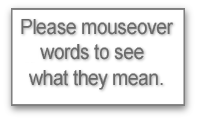Immune system - switching it on and off
18-November-2010
Immune system - switching it on and off
Sometimes it's a happy accident that throws people who are going to be friends together. The same is true of scientists who end up working with each other.
"Jim Brewer and I were put in the same lab twenty years ago, because they were short of space," says Paul Garside, professor of immunology at Glasgow University. "We've been collaborating ever since. Even the funding agencies regard us as a pair. We have joint grants, joint publications. It works really well."
One reason is that both scientists are trying to understand essentially the same thing: "the basic interactions of the immune response".
But that same science can be used to tackle two very different types of disease, says Paul.
"In autoimmune diseases, such as rheumatoid arthritis - which is very common in Glasgow - we want to know how to turn the immune response off.
"With infectious diseases on the other hand, we want to turn the immune response on.
"But if you understand how to turn something on you also understand how to turn it off."
Paul Garside
"So my main interest is in something called 'immunological tolerance'," he says. "That's where the immune system gets turned off, for some reason.
"We are investigating this by using advanced imaging techniques to see how cells move in living tissue in real time. Until now we've never been able to understand how cells interact. It used to be like trying to understand a game of football from still photographs."
He laughs. "As a Liverpool supporter - I remember being held up in the Kop, aged 5, to watch Ian St John play - I used to say that was fine if you were watching a team like Arsenal, where nobody moved." 
But the cells of the immune system are moving all the time. "It's a very dynamic system. So to understand the immune response we need to study exactly how those cells move."
That is precisely what the advanced imaging system at Glasgow University now allows scientists in the Division of Immunology, Infection and Inflammation to do.
Advanced imaging
"The multi-photon laser scanning microscope we've built is, we believe, the most advanced of its kind in the UK," says Professor Garside. "In fact there are only one or two others like it in Europe."
So what can be done with this sophisticated piece of scientific equipment? Well the new imaging system allows them to spy on the cells of the immune system as they go about their business.
And a complicated business it turns out to be. "We have found a layer of complexity we hadn't suspected," says Professor Garside. "And behaviours we never knew existed."
He turns to the computer on his desk and pulls up on screen a large image of green blobs and smaller red ones, all moving around. "So this is the immune response inside a lymph node," he says. "These are cells are talking to each other all the time."
On or off?
"Whether the immune response gets turned on or off depends on the details of what you're seeing on screen now," says Professor Garside. "This is real. It's not a simulation.
"When the immune response is turned on that's good if it's against pathogens or a vaccine. It's bad if it's against you."
So how do the green and red cells, which are communicating with each other all the time, decide among themselves if  they should mobilise the body's defences?
they should mobilise the body's defences?
It turns out that the decision depends strongly on the dynamics - on how the cells move and interact with each other. So the static images that scientists studied before this new imaging system was invented could not give the answer, Paul explains.
He hits a button and a smaller line graph appears on top of the moving cells. "What this shows is the area of contact between the cells of the immune response. It's called co-localization. That total area is what determines the outcome - whether the immune system is switched on or off."
Buzz
"This is what it looks like when the immune cells are talking to each other properly," he says, pointing to the graph.
Then he hits a button to pull up another graph. "But you don't see nearly as much of that here. That's because the immune cells are now responding to a molecule from the malaria parasite.
"And what this shows is that the malaria parasite reduces the amount of contact. It does that in the first 24 hours and that means your immune system doesn't work. We didn't know that before. We've learned it by using this new imaging system."
This example demonstrates why he loves doing science, Professor Garside says. "I like figuring out if an idea we had was right or wrong. I don't actually care if I'm right. I like challenging dogma.
"As head of a research group I no longer do the experiments myself. But I am very involved in designing and interpreting the experiments. I love finding out new stuff. That is the buzz."
Paul Garside's research is funded by Arthritis Research UK, BBSRC, and Wellcome Trust.
Words used in pop-ups
| antigen | bacterial | bacterium | biomedical | circulate | complex | conception | DNA |
| electromagnetic | fertilisation | fluid | gene | immune system | immunity | immune response | inherit |
| lymphatic system | mathematical model | microscopic | membrane | molecule | network | pathogen | process |
| protein | protoplasm | radiation | stimulates | structure | tissue | vessel | virus |
For other websites and resources relevant to this science story try the


